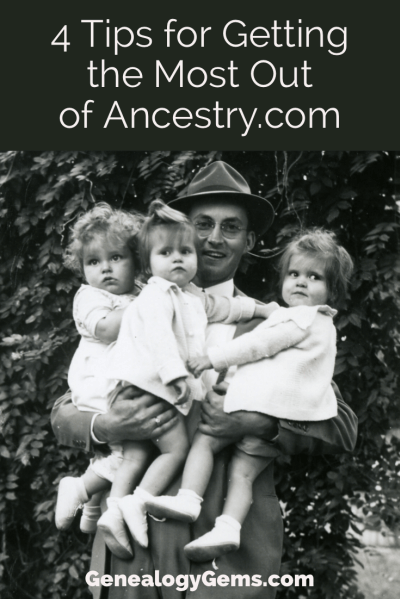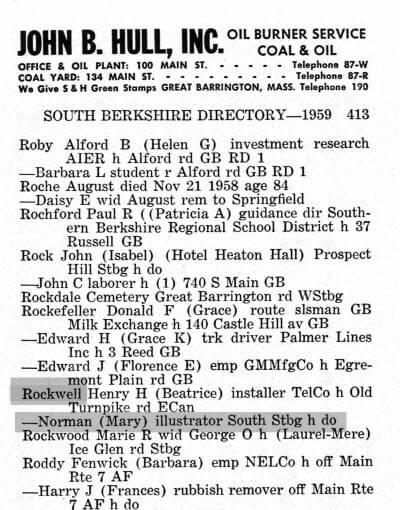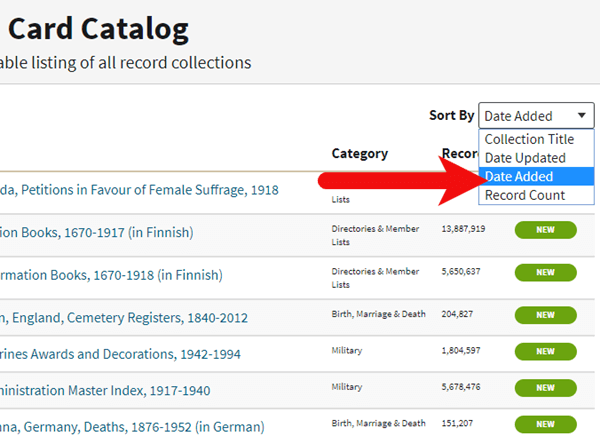by Lisa Cooke | Sep 5, 2015 | 01 What's New, Ancestry
When you invest your money in a genealogy website, you want to ensure that you’re getting the most value possible. Here we share tips for getting the most out of Ancestry.com.

I noticed recently that Ancestry subscribers’ attitudes run the same gamut as attitudes of big-box retailer shoppers. Some people {heart} them unabashedly: they’ll spend hours strolling the aisles and share every great find on social media. Others dash in and grab just the items they can’t live without.
Whatever your stance toward the site, Ancestry is still the big-box retailer most genealogists need at some point. Take your cue from top big-box store shopping strategies for getting the most out of Ancestry.com:
1. Grab first what you can’t get anywhere else.
Learn what exactly you want from Ancestry versus other sites, the same way you’ve learned whose house brand of spaghetti sauce you like and who carries your favorite protein bars.
A few examples for U.S. researchers:
- Ancestry has the most U.S. census non-population schedules online. (They’ve padded HeritageQuest Online with several of these but they didn’t give them everything.)
- Ancestry’s collection of digitized U.S. city directories (over a BILLION) is second to none.

Beloved illustrator Norman Rockwell in a city directory. (Massachusetts Berkshire 1959 Berkshire, Massachusetts, City Directory, 1959)
2. Stock Up on Items that are Easy to Reach
While your subscription is active, stock up on easy to find items.
One way to do that is with Ancestry’s hints. Ancestry’s hinting system taps the most popular Ancestry collections (about the top 10% of the most popular collections). Watch your Ancestry tree for hints and check them all. When you first log in, note whether anyone new has taken an interest in your tree (if it’s public)–and see if they are relatives worth contacting.
3. Watch for New Products!
We’ve written about Ancestry updates that have stopped us in our tracks, like the recent U.S. Wills and Probates and Social Security Applications and Claims databases and the AncestryDNA Common Matches Tool.
We also update you regularly on new records collections that go online throughout the genealogy world: Ancestry databases are often among them.
You can also sort by “Date Added” in Ancestry.com Card Catalog. This is a great way to see the collections most recently added. Look for the green “NEW” tag.

4. Avoid the Parts of the Experience that are Frustrating
Those who hate battling lines avoid big stores on peak shopping days and during the after-work rush. I avoid returning things at certain stores because their customer service desk is not worth the hassle.
Similarly, if the way Ancestry handles photos, sources, or Life Story timelines drives you nuts, ignore as much as you can except for your direct ancestors and closest relatives.
Perhaps you simply download each record you find and work with photos and timelines on your family history software (Lisa recommends RootsMagic–click here to read why). Or use Evernote’s newly updated web clipper (you can even make notes on top of your screen captures!) and store all your sources there.
Resources
Want to learn more about how to get the most out of Ancestry? Here are two additional resources:
Genealogy Gems Premium Podcast Episode 125: Using Ancestry Library Edition and other tips from a public library genealogist (available to Genealogy Gems Premium members only)
3 Things This Gems Follower Loves About the New Ancestry Site
by Lisa Cooke | May 28, 2015 | Beginner, Digital Archives, Libraries, Listeners & Readers, Research Skills, Travel, United States
 Recently we heard from Jennifer, who wondered what kinds of genealogy resources she might discover in a state capital.
Recently we heard from Jennifer, who wondered what kinds of genealogy resources she might discover in a state capital.
“I’m tagging along on my husband’s thesis research trip to Columbus, Ohio. I have some ancestors from other parts of Ohio. I was wondering what exactly I could look for in a state’s capital collections/archives that could save me a trip to the city or county? I was thinking that the state capital may have a “gem” that I couldn’t find elsewhere, or even duplicated information [from local repositories]. Do you know?”
Yes, Jennifer is definitely thinking along the right lines! Here’s our advice:
At the state level there are often two key resources: the state library and the state archives. These might be combined. One might be called the state historical society. You just have to look for each state. In Ohio, the Ohio History Connection serves as the state historical society and official state archives. But there is also a state library that serves as a repository for government documents and a resource for other libraries. Each has resources for genealogists, online and in-house. (Click here for digital genealogy content at the state library and here for resources at the Archives/Library of the Ohio History Connection).
In addition, public libraries of major cities often have excellent local history and genealogy collections. This is definitely true of the Columbus Metropolitan Library in Ohio’s state capital!
We suggest you contact librarians before you go and ask what they have that can’t be found anywhere else, both on a state level and for locales you are researching. Often times that will include photograph collections, company (business) collections, and my favorite newspapers on microfilm. If you can formulate specific genealogical questions that you want to try and answer and share those ahead of time with the librarian that will help her guide you toward the unique gems. Every state library and archive is unique, so consulting by phone with the reference librarian is the best way to go.
 Here are a few articles on my website that can help you prepare to find genealogy records in a state capital repository or in any major library:
Here are a few articles on my website that can help you prepare to find genealogy records in a state capital repository or in any major library:
by Lisa Cooke | Apr 17, 2015 | 01 What's New, Ancestry, FamilySearch, images, Records & databases, United States
 Do you have family from Puerto Rico? Newly-searchable at FamilySearch.org are Puerto Rico Civil Registrations. Ancestry published these last year for their subscribers. Ancestry describes this as their “largest single collection of Puerto Rican records.”
Do you have family from Puerto Rico? Newly-searchable at FamilySearch.org are Puerto Rico Civil Registrations. Ancestry published these last year for their subscribers. Ancestry describes this as their “largest single collection of Puerto Rican records.”
According to FamilySearch, “The civil registration records in Puerto Rico are an excellent source for genealogical research after 1885. Important genealogical data can be found in these records; see below. The data may even help to find information about an earlier generation.” They include birth, marriage and death records.
The description on FamilySearch indicates that records go back to 1805. But other hints (and a comparison to the Ancestry dataset) indicate that most of the records are for 1885 and later, just like Ancestry’s. Civil registration didn’t start in Puerto Rico until 1885 (before that, look to Catholic church records for BMD data). Of course, like many records, they may contain information about family dates and relationships from earlier in that person’s life.
 Those who know about Puerto Rico’s connection to the U.S. may wonder why Puerto Rico had civil registrations at a time that U.S. states and territories did not. Puerto Rico was actually a colony of Spain when civil registration started. Only after the Spanish-American War of 1898 did Puerto Rico become a U.S. protectorate.
Those who know about Puerto Rico’s connection to the U.S. may wonder why Puerto Rico had civil registrations at a time that U.S. states and territories did not. Puerto Rico was actually a colony of Spain when civil registration started. Only after the Spanish-American War of 1898 did Puerto Rico become a U.S. protectorate.
by Lisa Cooke | Apr 3, 2015 | 01 What's New, African-American, Ancestry, Australian, British, Canadian, Cemeteries, FamilySearch, Findmypast, Military, Records & databases, United States
Each Friday we share a list of selected new genealogy records online. Watch for records in which your ancestors might appear–and get inspired by the  kinds of records that may be out there waiting for you to discover. This week: Australian cemetery records, British military officer deaths, various U.S. passenger lists and North Carolina marriage records.
kinds of records that may be out there waiting for you to discover. This week: Australian cemetery records, British military officer deaths, various U.S. passenger lists and North Carolina marriage records.
AUSTRALIAN CEMETERY RECORDS. Two million indexed records have been added to the free Australia, Queensland Cemetery Records, 1802–1990 dataset at FamilySearch.org. According to the site, “The records include an index which combines several other indexes, cemetery transcriptions, burial and other records from cemeteries in Queensland….Cemetery records are especially helpful for identifying ancestors who were not recorded in other records, such as children who died young or women. They may also give clues to finding more information. In Australia, the first cemetery is reported to have been in Sydney in 1788.”
BRITISH MILITARY OFFICER DEATHS. FindMyPast’s new dataset, Royal Artillery Officer Deaths 1850-2011, lists the details of over 17,000 commissioned officers who were killed or died during the campaigns in Kosovo, Bosnia, Borneo and Iraq as well as the First and Second World Wars. It is estimated that since the regiment’s formation in May 1716, over 2.5 million men and women have served with the regiment. Each record includes a transcript of details found in the original records.
US PASSENGER LISTS. Browsable images were added to several existing US immigration records. Click here (and then scroll down) to view a table that has links directly to these datasets:
- For San Diego, CA:Airplane Passenger and Crew Lists, 1929–1954 and an apparently segregated Chinese Passenger and Crew Lists, 1905–1923;
- San Francisco, CA Passenger Lists, 1893–1953;
- Key West, FL Passenger Lists, 1898-1945;
- Minnesota Passenger Lists, 1910-1923;
- New York City, NY Passenger and Crew Lists Soundex (meaning an index based on how a name sounds), 1887-1921; (this is actually a new image collection)
- North Dakota Manifests of Immigrant Arrivals, 1910-1952 (this is also new).
NORTH CAROLINA (US) COUNTY MARRIAGES, 1741-2011. This new dataset on Ancestry “includes images of marriage bonds, licenses, certificates, and registers from 87 different counties.” According to an Ancestry blog post, some marriages have multiple records in this collection, like a bond and an indexed marriage record. This record set may be particularly useful for those tracing African-American marriages, as they “reference the joining of couples living as man and wife dating back to 1820, and possibly earlier…. Sometimes they also include the names of their former owners.” There’s a free, similar-looking dataset at FamilySearch, but the dates aren’t as extensive (it covers 1762-1979).
 Tip: When searching within record sets like these, read the record collection description! Sometimes you are just seeing a partial collection that is being updated on an ongoing basis. Some years or locales may be missing from an otherwise complete record set.
Tip: When searching within record sets like these, read the record collection description! Sometimes you are just seeing a partial collection that is being updated on an ongoing basis. Some years or locales may be missing from an otherwise complete record set.
When you have questions that aren’t answered in the record collection description online, Google them! Use keywords like the type of record (“marriage records”) and the missing locale (“Burdett County”) to see whether other sites can lead you to these records or confirm that they don’t exist. Learn more about advanced Google searching for genealogy in the fully-updated 2nd edition of The Genealogist’s Google Toolbox by Lisa Louise Cooke.









 kinds of records that may be out there waiting for you to discover. This week: Australian cemetery records, British military officer deaths, various U.S. passenger lists and North Carolina marriage records.
kinds of records that may be out there waiting for you to discover. This week: Australian cemetery records, British military officer deaths, various U.S. passenger lists and North Carolina marriage records. Tip: When searching within record sets like these, read the record collection description! Sometimes you are just seeing a partial collection that is being updated on an ongoing basis. Some years or locales may be missing from an otherwise complete record set.
Tip: When searching within record sets like these, read the record collection description! Sometimes you are just seeing a partial collection that is being updated on an ongoing basis. Some years or locales may be missing from an otherwise complete record set.